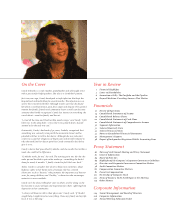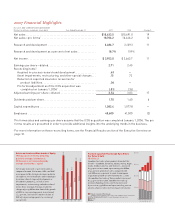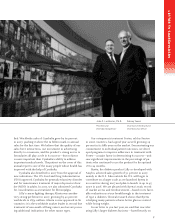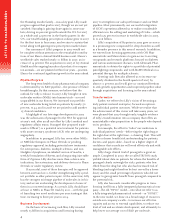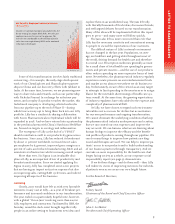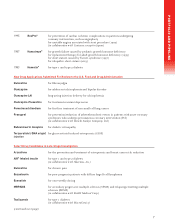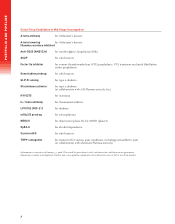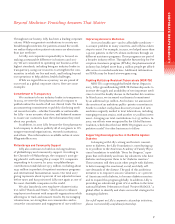Eli Lilly 2007 Annual Report Download - page 6
Download and view the complete annual report
Please find page 6 of the 2007 Eli Lilly annual report below. You can navigate through the pages in the report by either clicking on the pages listed below, or by using the keyword search tool below to find specific information within the annual report.
4
the Humalog insulin family—was a key goal. Lilly made
progress against that goal in 2007, though we are not yet
satised. Humalog is gaining share again in some mar-
kets, driving 20 percent growth outside the U.S. for 2007
as a whole and 32 percent in the fourth quarter. In the
U.S., our total Humalog prescription volume grew in 2007
for the rst time in four years, and we aim to sustain that
trend along with gaining new-prescription market share.
Our summary of Lilly’s progress in 2007 would not
be complete without attention to the remarkable contribu-
tions of our Elanco Animal Health business unit. Elanco’s
worldwide sales reached nearly $1 billion in 2007, an in-
crease of 14 percent. The acquisition in 2007 of Ivy Animal
Health and the ongoing launches of products for compan-
ion animals—six are planned within four years—position
Elanco for continued signicant growth in the years ahead.
Pipeline Progress
The long-term health of any pharmaceutical company
is determined by its R&D pipeline—the promise of future
breakthroughs. By that measure, we believe that the
outlook for Lilly is robust. In 2007, Lilly brought 16 new
molecular entities (NMEs) into human trials—a record
unparalleled in our history. We increased our portfolio
of new molecules being tested on patients by nearly 50
percent, to 44, and in 2008 we are poised to add another
15 clinical candidates.
A highlight of our late-stage development in 2007
was the submission of prasugrel to the FDA for approval
at year’s end, after an all-out effort by Lilly’s medical and
regulatory affairs teams. Prasugrel (the proposed trade-
mark is Efent™) is a potential new treatment for patients
with acute coronary syndrome (ACS) who are undergoing
angioplasty.
In addition to prasugrel, Lilly has seven other NMEs
or NME-like therapies in Phase III trials or pending
regulatory approval, including potential new treatments
for osteoporosis, diabetes, multiple sclerosis, and non-
Hodgkin’s lymphoma, an inhaled version of insulin, a
weekly formulation of Byetta, and a long-acting injectable
form of Zyprexa. Lilly also has more than a dozen new
indications, line extensions, and delivery devices in Phase
III trials or under regulatory review.
If successful, most of those therapies will be approved
between 2008 and 2011, further strengthening Lilly’s prod-
uct portfolio as older patents expire. At the same time, Lilly
has the strongest mid-stage pipeline of molecules in its his-
tory, and we are accelerating the development of some of
them in a concerted strategy. As a result, Lilly should have
at least 10 NMEs in Phase III trials by 2011—with the goal
of launching two novel medicines per year starting at that
time, increasing to three per year in 2014.
Business Development
On the basis of increasing cash ow, Lilly invested
nearly $3 billion in acquisitions and licensing during
2007 to strengthen our sales performance and our R&D
pipeline. Most prominently, our successful integration
of ICOS’s operations allowed us to realize considerable
efciencies in the selling and marketing of Cialis—which
posted a 25 percent increase in worldwide sales in 2007,
to $1.216 billion.
Lilly’s acquisition of Hypnion in 2007 gave us access
to a promising new compound for sleep disorders as well
as a broader presence in this area of research. In addition,
we entered into licensing agreements with OSI Phar-
maceuticals and MacroGenics to gain access to exciting
compounds and research platforms focused on diabetes
and various autoimmune diseases, with Glenmark Phar-
maceuticals to obtain the rights to a portfolio of potential
pain-ghting compounds, and with BioMS Medical on a
potential therapy for multiple sclerosis.
Growing cash ow also allowed us to increase our
quarterly dividend in the fourth quarter of 2007 by
almost 11 percent, and it will give us continued freedom
to seek growth opportunities and improved pipeline value
through acquisitions and licensing in the years ahead.
Transformation
Earlier, we referred to Lilly’s vision of becoming a
truly patient-centered enterprise, focused on optimiz-
ing individual patient outcomes. While we realize that
the achievement of this vision will take many years, we
were pleased that 2007 brought early, tangible evidence
of Lilly’s transformation into a company that offers an
unmistakable value proposition to the people who depend
on its products.
For example, the effort to “tailor” our medicines to
individual patients’ needs—delivering the right drug at
the right dose at the right time—is bearing fruit. This will
lead to a clearer benet/risk understanding for patients,
doctors, and payers alike—based on a higher degree of
condence that a medicine will work effectively and with
manageable side effects.
Lilly’s large clinical trial of prasugrel is a great ex-
ample. Completed in 2007, the so-called TRITON study
yielded robust data on patients for whom the benets of
prasugrel clearly outweigh the risks; patients who ben-
eted from the drug but who also had increased risk of
bleeding (and might therefore be best served by a lower
dose); and the small percentage of patients who did not
appear to gain greater benet from prasugrel compared to
the potential risk.
Lilly also has made considerable progress in trans-
forming itself from a fully-integrated pharmaceutical com-
pany—the old “FIPCO” model—into what we refer to as
a fully-integrated pharmaceutical network—or “FIPNET.”
In the new model, we draw on a broad range of resources
outside our company’s walls—to increase our effective
capacity and access to external capabilities, to reduce our
level of risk and accelerate development, and ultimately to
help lower our average cost of R&D per molecule.


